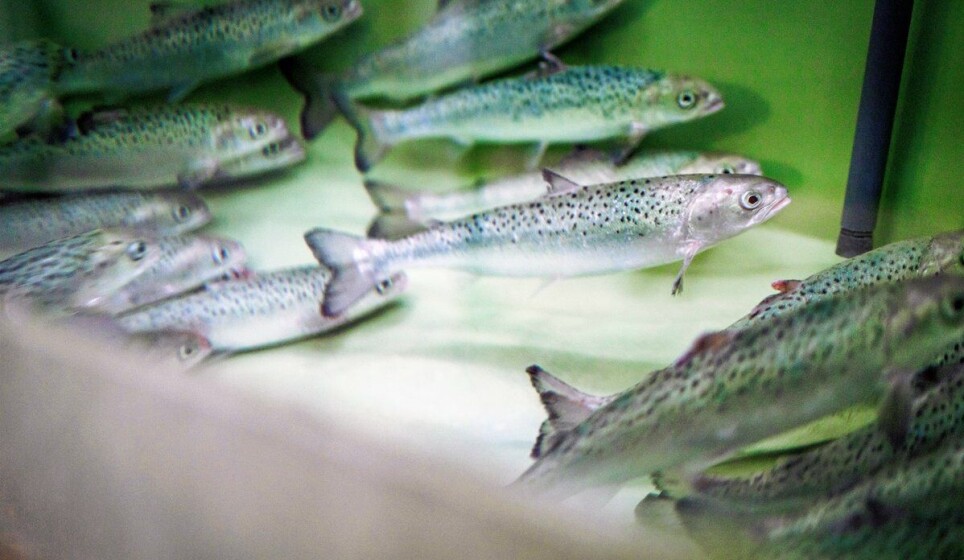THIS ARTICLE/PRESS RELEASE IS PAID FOR AND PRESENTED BY the Institute of Marine Research - read more

‘Power naps’ prevent early puberty in farmed salmon
Researchers have discovered the ideal length of day for smolts.
Farmed salmon start their lives in freshwater tanks on land. The farmers leave the lights on all day long, which means that it is permanently 'daytime' for the young salmon. This results in them eating more and growing faster.
But in order for the salmon to become ready for salt water (undergo smoltification), the farmers must first go down to 12-hour ‘winter days’, before returning to 24-hour days.
Unwanted puberty is a side-effect
This makes the salmon think that winter is giving way to spring, and that it is time to migrate out to sea. They then undergo smoltification.
But messing around with the light like this has an unwanted side effect: Some of the male salmon enter sexual maturity.
Sexually mature salmon are more prone to illness and grow less quickly.
21-hour days were better than 24-hour days
In a new study, researchers have shown that you can minimise this problem with a ‘power nap’.
“When the day was shortened from 24 hours to 21 hours followed by a brief night lasting three hours, only ten per cent of the fish reached sexual maturity. By contrast, thirty per cent of the fish became sexually mature using the traditional method,” Thomas Fraser, a researcher at the Institute of Marine Research (IMR), says.
Other researchers at the IMR have previously shown that no fish reach sexual maturity if you use a short day lasting just six hours. But that means you also miss out on many hours of feeding and growth.
“We wanted to find the best possible compromise,” says Fraser.
And that is what they did. It turned out that going from winter days to both 18- and 21-hour days allowed the fish to undergo smoltification in the normal way, while significantly reducing the risk of them sexually maturing.
How the experiment was conducted
The researchers split 380 mixed sex juvenile salmon into 6 tanks.
All of the tanks were exposed to light that simulated a winter’s day, before it was increased to:
- Constant light in two tanks
- 21 hours of light and three hours of ‘night’ in two tanks
- 18 hours of light and six hours of ‘night’ in two tanks
The fish were kept under these conditions for six weeks.
No problem for female salmon
The researchers performed tests to detect signs of puberty, such as measuring testosterone levels in blood.
“As expected, none of the female salmon entered puberty. This issue isn’t a problem for them, because they sexually mature a bit later than males in the wild as well,” Fraser explains.
- 33 per cent of the males exposed to constant light showed signs of sexually maturing.
- 10 per cent of the males exposed to 21 hours of light per day showed signs of sexually maturing,
- as did 12 per cent of those exposed to 18 hours of light.
“So, we have shown that for males it only takes three hours of darkness per day to reduce early sexual maturation after smoltification,” Fraser concludes.
Reference:
Fraser et al. Atlantic salmon male post-smolt maturation can be reduced by using a 3-hour scotophase when inducing smoltification, Aquaculture, vol. 562, 2023. DOI: 10.1016/j.aquaculture.2022.738772

This article/press release is paid for and presented by the Institute of Marine Research
This content is created by the Institute of Marine Research's communication staff, who use this platform to communicate science and share results from research with the public. The Institute of Marine Research is one of more than 80 owners of ScienceNorway.no. Read more here.
See more content from the Institute of Marine Research:
-
These whales have summer jobs as ocean fertilisers
-
Have researchers found the world’s first bamboo coral reef?
-
Herring suffered collective memory loss and forgot about their spawning ground
-
Researchers found 1,580 different bacteria in Bergen's sewage. They are all resistant to antibiotics
-
For the first time, marine researchers have remotely controlled an unmanned vessel from the control room in Bergen
-
New discovery: Cod can adjust to climate change – from one generation to the next




































